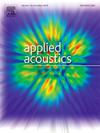Feedback control of car cabin noise using sound field compensation
IF 3.4
2区 物理与天体物理
Q1 ACOUSTICS
引用次数: 0
Abstract
In this paper, feedback control is adopted to reduce the noise around two ears of a person in a seat in a car with an active noise control headrest system which has two microphones and two loudspeakers installed on the headrest. For each ear side, the microphone is closer to the loudspeaker than the ear and has a short latency in the secondary path, so it is used for feedback control. The target signal for the control is generated by compensating the microphone signal with the spatial property between the microphone and ear positions. Then a servo control system consisting of the secondary source and microphone is employed to follow the target signal, and noise reduction at the ear position is realized when the difference between the target signal and output of the servo control system is minimized. The noise reduction at the ear position obtained with this compensated target control signal (referred to as the compensation control) is compared with that from applying feedback control directly to the microphone (referred to as the direct control). Both simulation results using recorded road noise in an electric car cabin and the real-time experiment results on road are presented to demonstrate that the compensation control can achieve higher noise reduction than the direct control at the ear positions.
求助全文
约1分钟内获得全文
求助全文
来源期刊

Applied Acoustics
物理-声学
CiteScore
7.40
自引率
11.80%
发文量
618
审稿时长
7.5 months
期刊介绍:
Since its launch in 1968, Applied Acoustics has been publishing high quality research papers providing state-of-the-art coverage of research findings for engineers and scientists involved in applications of acoustics in the widest sense.
Applied Acoustics looks not only at recent developments in the understanding of acoustics but also at ways of exploiting that understanding. The Journal aims to encourage the exchange of practical experience through publication and in so doing creates a fund of technological information that can be used for solving related problems. The presentation of information in graphical or tabular form is especially encouraged. If a report of a mathematical development is a necessary part of a paper it is important to ensure that it is there only as an integral part of a practical solution to a problem and is supported by data. Applied Acoustics encourages the exchange of practical experience in the following ways: • Complete Papers • Short Technical Notes • Review Articles; and thereby provides a wealth of technological information that can be used to solve related problems.
Manuscripts that address all fields of applications of acoustics ranging from medicine and NDT to the environment and buildings are welcome.
 求助内容:
求助内容: 应助结果提醒方式:
应助结果提醒方式:


